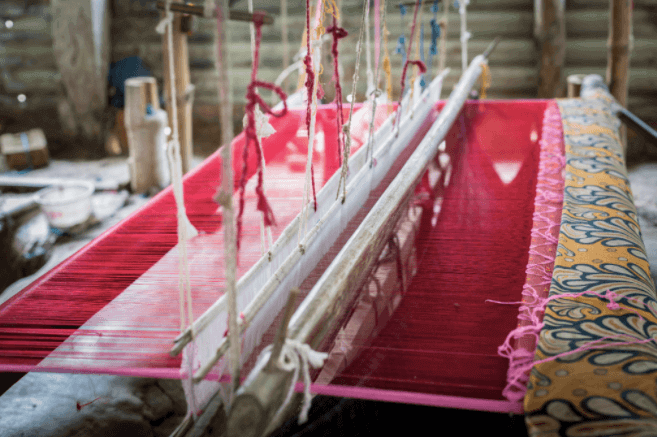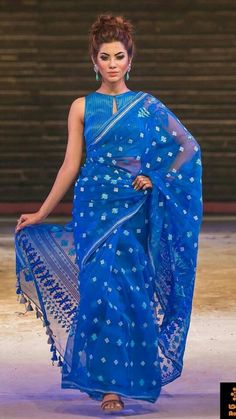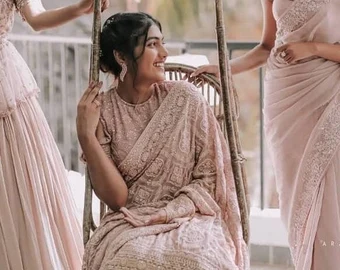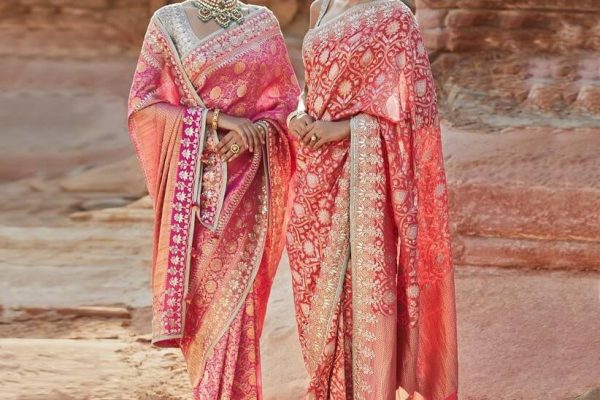
Origin and History Of Jamdani Saree
Jamdani is a traditional textile weaving technique that originated in the region of Bengal, which encompasses parts of present-day Bangladesh and West Bengal in India. The term “jamdani” is believed to be derived from two Persian words: “jam,” meaning flower, and “dani,” meaning vase or container. This name reflects the intricate and delicate floral motifs that are a characteristic feature of jamdani textiles.
The exact origins of jamdani are not definitively documented, but it is thought to have a history dating back over a thousand years.
The history of jamdani is rich and spans centuries, showcasing the creativity, craftsmanship, and cultural heritage of the people of Bengal, particularly in present-day Bangladesh and West Bengal, India. This intricate weaving technique has a fascinating journey that has been influenced by various dynasties, cultures, and historical events. Here’s a brief overview of the history of jamdani:
Ancient Roots: The origins of jamdani are believed to date back over a thousand years. The exact timeline is not definitively documented, but it is thought that the art of jamdani weaving evolved from the traditional muslin fabric weaving techniques of the region. The technique of using a supplementary weft to create intricate patterns on the fabric gradually developed.
Mughal Era: The Mughal period, particularly during the reign of Emperor Akbar (r. 1556–1605), marked a significant turning point for jamdani. The Mughal emperors were patrons of art and culture, and they played a crucial role in the growth and refinement of the textile industry. Jamdani fabrics gained prominence in the royal courts and among the aristocracy. The intricate patterns and delicate motifs captured the attention of connoisseurs of art and aesthetics.
Height of Excellence: The 17th and 18th centuries were the golden age of jamdani. The technique reached its pinnacle of excellence during this period. Highly skilled weavers in the region of Dhaka (now in Bangladesh) produced some of the most exquisite and sought-after jamdani textiles. The craftsmanship was so renowned that it was considered a luxurious commodity and was highly valued in trade and diplomacy.
British Colonial Period and Decline: With the advent of British colonial rule in the Indian subcontinent, the jamdani industry faced challenges. The colonial economic policies and industrialization had an impact on the traditional craft, leading to a decline in its production. The introduction of mechanized textile production and changing fashion trends posed challenges to the handcrafted jamdani.
Revival and Contemporary Scenario: In the mid-20th century, efforts were made to revive the jamdani tradition. Various organizations, cultural enthusiasts, and artisans worked together to preserve the art form. The revival of jamdani brought attention to its cultural significance and artistic value, leading to increased appreciation both domestically and internationally.
Today, jamdani continues to captivate people with its intricate patterns, delicate motifs, and cultural significance. It has transcended time and remains an emblem of the rich heritage and artistic prowess of Bengal. Artisans and weavers continue to create jamdani textiles, blending traditional techniques with contemporary designs to cater to modern sensibilities while honoring the craft’s historical roots. Efforts to sustain and promote jamdani’s legacy include workshops, exhibitions, and cultural events that celebrate its enduring beauty and cultural importance.

people involved in the making process of jamdani Saree
Artisans: These are skilled workers who create jamdani fabrics. They use their hands and special tools to weave the beautiful patterns and designs that make jamdani unique.
Weavers: Weavers are the people who actually make the fabric by interlacing threads together. They follow traditional techniques to create the delicate and intricate jamdani patterns.
Designers: These creative individuals come up with the patterns and designs that are woven into the fabric. They imagine how the final product will look and guide the weavers to bring their ideas to life.
Dyers: Dyers are responsible for adding color to the threads that will be woven into the fabric. They use special dyes to create the vibrant colors you see in jamdani textiles.
Spinners: Spinners are the ones who turn raw cotton into thread. They use machines to spin the cotton fibers into thin threads that are strong enough to be woven.
Thread Makers: These people take the spun threads and wind them onto spools or bobbins, making it easier for the weavers to work with the threads while creating the fabric.
Pattern Tracers: Pattern tracers copy the intricate designs onto special paper. These patterns help guide the weavers as they create the detailed motifs in the fabric.
Finishing Workers: After the fabric is woven, finishing workers check it for any imperfections and make sure it’s smooth and ready for use.
Supportive Families: Behind each artisan or weaver is often a family that supports their work. They help with tasks like preparing materials, taking care of the household, and more.
Cultural Promoters: These are people and organizations that appreciate and promote the value of jamdani as a traditional craft. They might organize events, exhibitions, and workshops to keep the tradition alive.
All of these people work together to create the beautiful and intricate jamdani textiles that have been a part of Bangladesh’s culture for a long time.
Making process
Step 1: Choosing the Design First, the weaver decides on the design for the jamdani cloth. This design includes patterns and motifs that will be woven into the fabric.
Step 2: Setting up the Loom A loom is a special tool used for weaving. The weaver sets up the loom with threads stretched horizontally (these are called the warp threads) and vertically (these are called the weft threads).
Step 3: Preparing the Pattern The weaver prepares a pattern chart that shows where the special designs will go in the fabric. This helps them know where to add extra threads to make the designs.
Step 4: Adding the Supplementary Weft This is the special part of jamdani weaving. The weaver takes a thin thread with a different color from the main fabric and weaves it in by hand to create the patterns. They follow the pattern chart and carefully add the extra threads to make the beautiful designs.
Step 5: Weaving the Main Fabric While adding the supplementary threads, the weaver also continues to weave the main fabric using regular threads. This is done by passing the weft thread over and under the warp threads.
Step 6: Repeating the Process The weaver repeats the process of adding the supplementary weft and weaving the main fabric over and over again until the whole cloth is complete. This takes a lot of skill and patience!
Step 7: Finishing the Cloth Once the weaving is done, the weaver carefully finishes the edges of the cloth and removes it from the loom.
Step 8: Washing and Finishing The finished cloth is washed to remove any extra threads and to make it soft. Then, it might be dyed to get the desired colors. Finally, the cloth is ready to be used for making clothes, scarves, or other beautiful items.
Step 9: Sharing the Craft The process of making jamdani involves a lot of skill and tradition. Many weavers in Bangladesh take pride in creating these special fabrics. By continuing to make and share jamdani, they help keep this traditional craft alive for future generations to enjoy.
That’s a simplified explanation of the jamdani-making process in Bangladesh!

What are some of the motifs one will usually find on a Jamdani saree?
Different types of jamdani saree
There are several different types of Jamdani sarees, each characterized by unique weaving techniques, motifs, and regional influences. Here are some of the notable types:
Dhakai Jamdani: Originating from Dhaka, the capital city of Bangladesh, Dhakai Jamdani is one of the most famous and traditional types of Jamdani sarees. These sarees are woven using a fine muslin fabric and often feature intricate floral and geometric patterns. Dhakai Jamdani sarees are known for their sheer texture, lightweight feel, and elaborate craftsmanship.
Shantipur Jamdani: Shantipur, a town in West Bengal, India, is renowned for its production of Shantipur Jamdani sarees. These sarees often incorporate intricate designs of birds, animals, and nature-inspired motifs. Shantipur Jamdani sarees are typically made using cotton threads and are favored for their comfort and elegance.
Tangail Jamdani: Named after the Tangail district in Bangladesh, Tangail Jamdani sarees are characterized by their unique and artistic patterns. These sarees often feature large motifs and a mix of geometric and floral designs. They are known for their versatility, making them suitable for both casual and formal occasions.
Dhaniakhali Jamdani: Dhaniakhali, another region in West Bengal, produces Dhaniakhali Jamdani sarees. These sarees are woven with a combination of colorful cotton and zari threads, resulting in vibrant and eye-catching patterns. The motifs on Dhaniakhali Jamdani sarees range from traditional to contemporary, catering to a wide range of preferences.
Dhonekhali Jamdani: Similar to Dhaniakhali Jamdani, Dhonekhali Jamdani sarees are also woven in the Dhonekhali region of West Bengal. These sarees often showcase intricate patterns that are achieved through the combination of colored threads and zari work.
Narayanganj Jamdani: Produced in the Narayanganj district of Bangladesh, Narayanganj Jamdani sarees are known for their soft texture and elegant designs. They often feature delicate floral patterns and are woven using fine cotton threads.
Rampur Boalia Jamdani: Hailing from the Rampur Boalia area in Bangladesh, these sarees are characterized by their unique weaving technique, where the motifs are woven in a way that they appear on both sides of the fabric. This intricate method adds to the beauty and complexity of the saree.
These are just a few examples of the many types of Jamdani sarees that exist, each with its own distinct characteristics and regional influences. The art of crafting Jamdani sarees is highly skilled and labor-intensive, making each piece a masterpiece of handwoven artistry.
The price of an original Jamdani saree
The price of an original Jamdani saree can vary widely based on several factors, including the quality of the fabric, the intricacy of the design, the reputation of the weaver or brand, the type of motifs used, and the overall craftsmanship. Authentic Jamdani sarees that are handwoven using traditional techniques tend to be more expensive due to the time and skill required to create them.
In Bangladesh, you can find Jamdani sarees at various price points:
Lower Range: Lower-priced Jamdani sarees might start from around $50 to $100 or even less. These sarees may have simpler designs, fewer supplementary weft motifs, and could be made with less expensive materials.
Mid-Range: Mid-range Jamdani sarees with more intricate designs, finer materials, and a higher level of craftsmanship can range from $100 to $300.
Higher Range: For high-end and designer Jamdani sarees, the prices can go beyond $300 and even reach several thousand dollars. These sarees are likely to feature exquisite designs, premium materials, and exceptional craftsmanship.
Keep in mind that these are general price ranges and can vary based on the specific features of each saree. Additionally, prices may differ based on where you purchase the saree, whether it’s directly from weavers, local markets, boutiques, or online platforms.
When considering the price of a Jamdani saree, it’s important to take into account the quality of the craftsmanship, the authenticity of the weaving technique, and the materials used. Authentic and original Jamdani sarees are valuable not only for their beauty but also for their cultural and traditional significance.
Where to BUY the latest Jamdani saree?
There are several places where you can purchase them. In Bangladesh, you can visit popular shopping districts like Dhaka’s New Market, Bashundhara City Mall, or Aarong outlets, which offer a variety of authentic Jamdani sarees. Additionally, you can explore local markets in Tangail, where Tangail Jamdani sarees are available. Online platforms such as Aarong’s website, various e-commerce platforms, and websites of reputable boutiques offer the convenience of browsing and purchasing Jamdani sarees from the comfort of your home. Remember to verify the authenticity and credibility of the seller before making a purchase.




